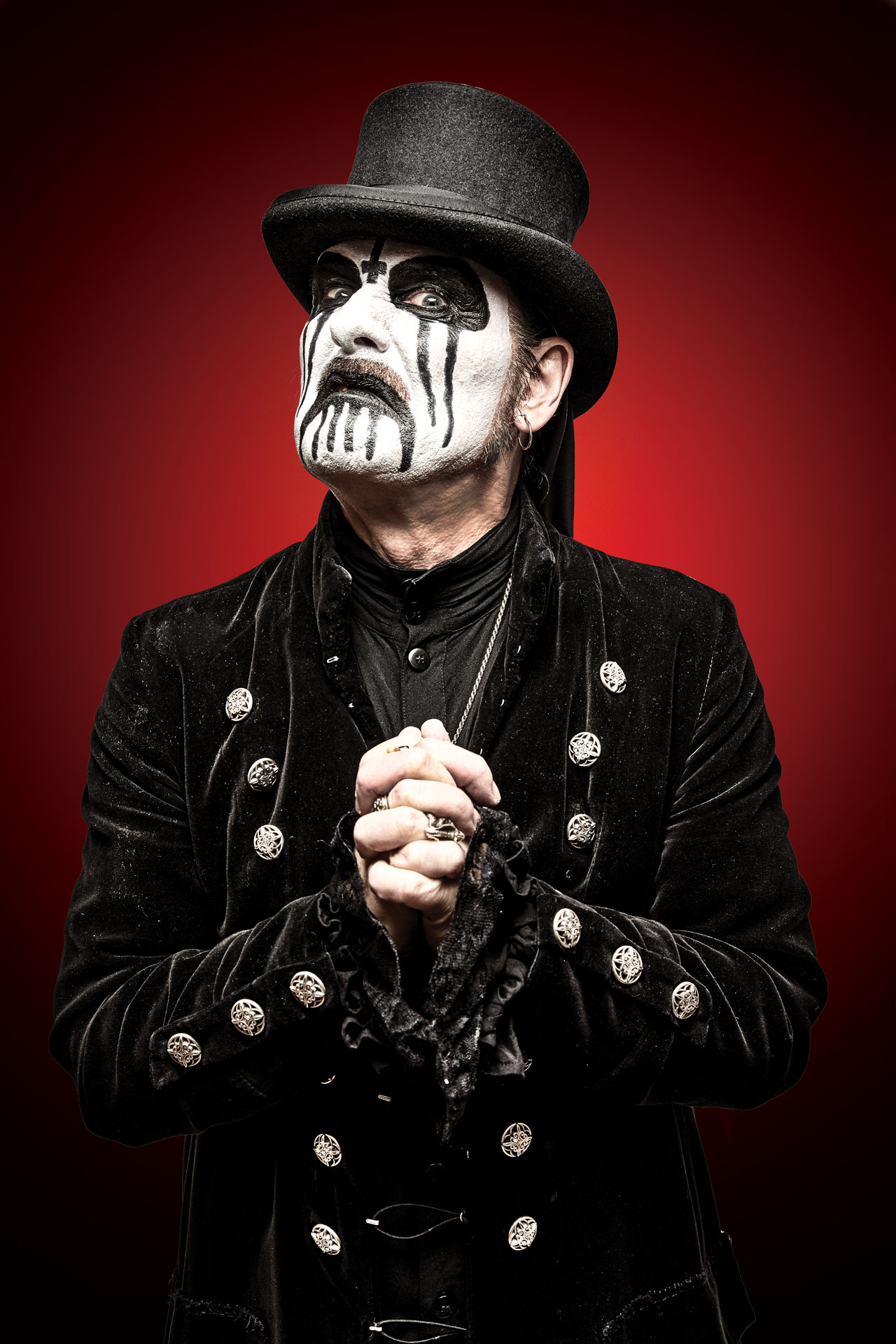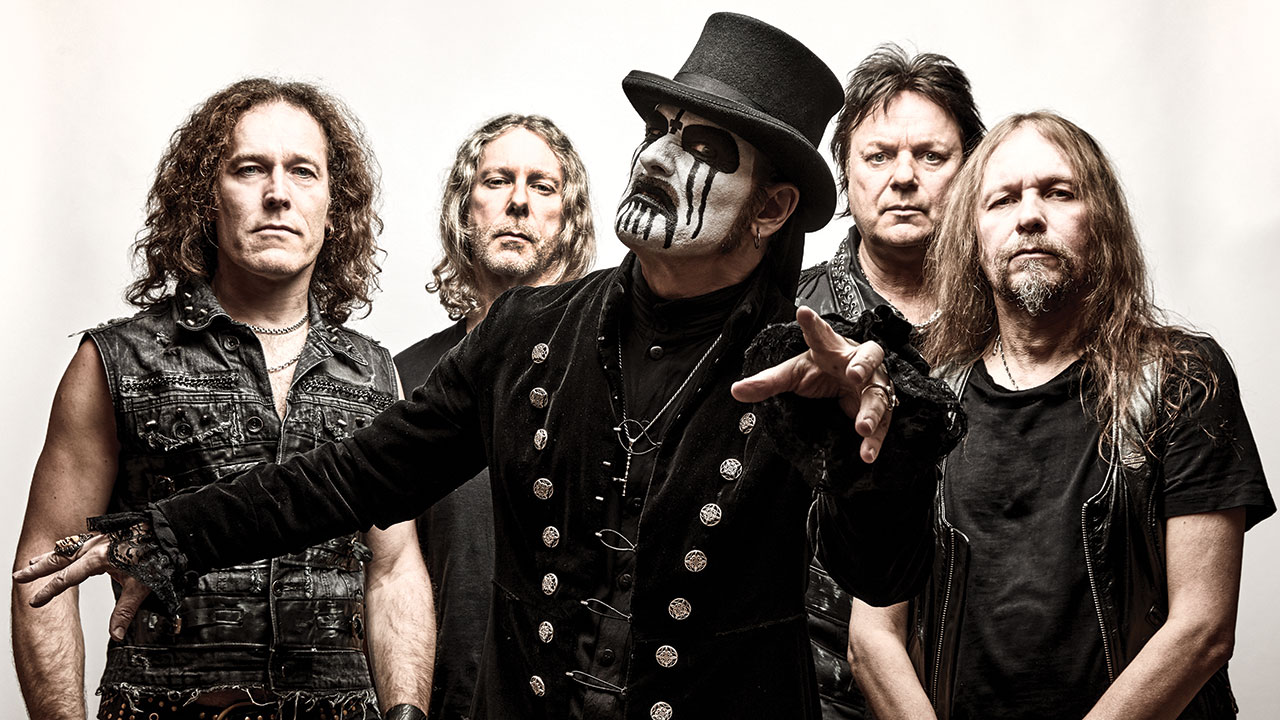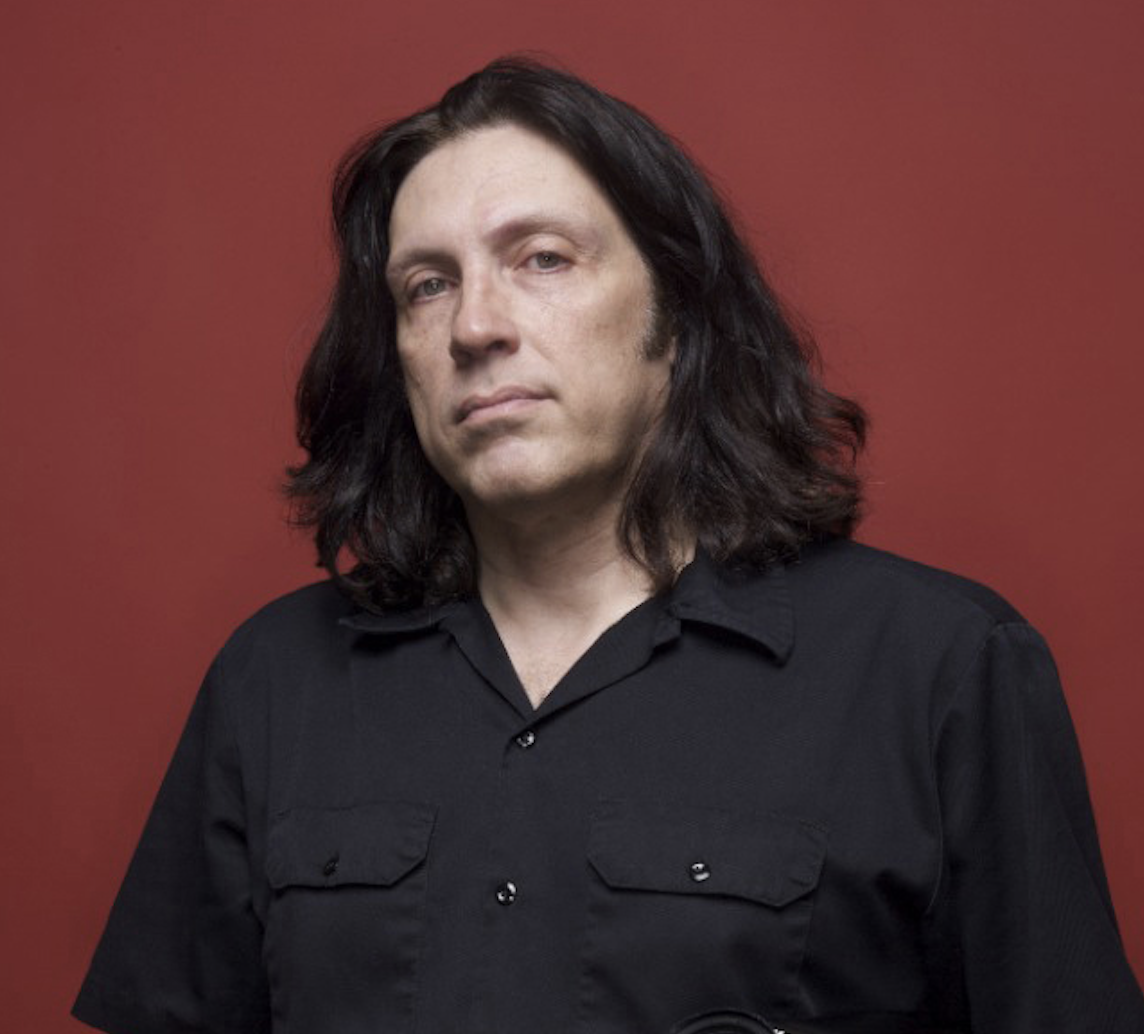In the basement of an old Art Deco theatre in Los Angeles, the man known as King Diamond arrives with a strange aura of calm, a mystery man of gothic elegance and few words in a top hat and demonic facepaint. It’s the small crowd of VIP fanatics who look nervous, as they line up to meet the iconic singer and his band.
Diamond - real name Kim Bendix Petersen - is near the end of 23 tour dates across the US, raging and shrieking through songs from his nearly four-decade career.
These are his first shows to include regular fan meet-and-greets. He’s known to the metal faithful as both solo artist and the hugely influential, multi-octave voice of Mercyful Fate, and the reactions can be extreme, as fans take turns posing for snapshots and bearing gifts.
“Great to meet you,” says one dude as he shakes Diamond’s hand, impulsively hugging the Dane. Another fan is so nervous he can barely look at Diamond, who smiles warmly, his eye-sockets painted black. A woman in a Misfits shirt and shorts, her legs covered in tattoos, asks for an autograph on her thigh.
For many of these fans, Diamond is a monumentally important figure in the history of metal, and a core inspiration to Metallica and generations of players. But away from the stage, the singer is focused on the present and near-future, which promises to be his most prolific period of the millennium: a new King Diamond album this year, a summer tour of European festivals with a reunited Mercyful Fate, and plans to begin work on that band’s first new album in more than two decades.
The next King Diamond album has been gestating in his mind for years now, and he says: “It’s going to be some mystical cool shit. We really have high hopes for this one.” The singer has already conceived of certain theatrical effects for the live show, with torture and shock therapy included. “It is quite sick, but in a cool way for the story.”
A first clue to the sound and direction of the new album came at the start of the US tour, with the single Masquerade Of Madness. The cover art depicts a young girl in pigtails and iron mask trapped in an asylum, while the sound is all charged riffing from guitarists Andy LaRocque and Mike Wead, as Diamond wails: ‘There is a girl in misery / And insanity / Painting figures on her walls / Those voodoo dolls.’
I looked like a corpse. I was blue, black and brown.
King Diamond
The rest of the album, to be titled The Institute, will be inspired by early 20th-century imagery of inmates in a mental asylum he’s seen in vintage photographs. It will also draw from his own near-death experiences in hospitals, following a series of heart issues that led to triple-bypass surgery in 2010.
His experiences with hospitals and doctors were mostly good, Diamond says, but the experience was still traumatic, opening his rib cage, sidelining him from the road for an extended period. Naturally, the first days after his surgery were especially hard.
“I looked like a corpse, I swear,” he recalls. “My hands and my face were white. Everything else looked like I’d been washed up on a beach. I was blue, black, brown. I could barely lift a glass of water.”
During his recovery, Diamond began to imagine that he’d actually died on the operating table, and was now merely a spectre haunting his Hungarian-born wife, singer Livia Zita.
Was he really here? He would suddenly grab her shoulder or raise a hand to make sure she knew he was in the room. “It was so weird. I felt like I didn’t belong,” he remembers grimly. “Why would I be here when I was dead?”
Six months later, Diamond had his first meeting with the band and crew. Since he’d quit smoking just before the surgery, he was shocked to find new power in his lungs, which continues today: “I don’t think my voice ever sounded better than it does right now.”
There was still sadness this winter, while Diamond was on the road with his band, with the death of Timi Hansen, bassist for Mercyful Fate. The singer had once hoped his former collaborator and touring roommate would be part of the 2020 reunion. For a moment, his cancer had seemed to be in remission. A month later, the fight suddenly got tougher.
“It all went south, and you realise that, OK, maybe he can’t do it, but all the time that I talked to Timi, I said to him: ‘You know the spot is yours. Don’t stress about anything with the band. You just need to know that the position is yours whenever it’s feasible to you.’”
Diamond was on the phone with Timi just 10 days before his death. “He was one of my favourite – if not the favourite – bass triggers,” Diamond says now. “His style of playing had the same touch and specialty as Gary Thain from Uriah Heep or Geezer Butler [of Black Sabbath] – bass players who are amazing.”

The night before his Los Angeles concert, Diamond was across town at the final performance of Slayer, the band of thrash originators who have called Diamond and Mercyful Fate a core influence. He was there at the Forum in Inglewood as both colleague and fan.
He brought along his toddler son, Byron. “The little guy will be three years old in March, and that was his first concert that he saw,” Diamond says proudly. “He saw the first four songs, and his mouth was wide open.”
Like many at the sold-out arena show, Diamond attended with mixed emotions, as he watched the essential thrash act leave the stage one final time. “It’s so strange, bittersweet,” he says. “They belong. I don’t know how to say this – it is not my decision - but they don’t seem to be at the stage where they are done.”
Slayer are just the most recent of major acts to exit the stage, following Motörhead and Black Sabbath, among other icons sure to follow. At 63, King Diamond has been at it as long as many of them, but has no expectations of slowing down, just as long as he’s able to raise his crossbones microphone. His health crisis was merely a setback, inspiring new habits regarding his health: no smoking, more sleep, healthy food.
His theatrical approach to metal is physically demanding, as always. It begins each night with two hours in front of the mirror, putting on his make-up. A look at early pictures of Diamond onstage shows how much the make-up has evolved over the decades. He’s better at it now, painting the whites and blacks, the crosses and shadows, with new precision and focus.
The nightly ritual typically begins at the hotel in the late afternoon, sitting with a cup of coffee. He usually listens to a recording of the live set at least twice, inspiring himself for the performance ahead. “It’s part of me,” he says of the war paint. “There’s no way I could let it go.”
For him, the idea began after seeing Peter Gabriel’s theatrical performance with Genesis in 1974, with the singer in black- and-white facepaint and elaborate costume, playing “progressive, pretty heavy songs for the time”.
Then came Alice Cooper’s Welcome To My Nightmare tour the following year. The experiences left a mark on the young rocker.
“The make-up meant that you could see their facial expressions way into the audience and not just the front row,” he recalls. He decided: “If I ever get to play in a band, I’m gonna use that, guaranteed. There was no doubt in my mind.”
He put make-up on from his very first band, Brainstorm, using only black make-up on bare skin at this early stage. By then he had already grown up as a teenage rock’n’roll fanatic, seeing as many live concerts as he could.
The future frontman waited desperately for the debut Queen album in 1973, calling his local record shop every day after hearing the single Keep Yourself Alive repeatedly on the radio. “You would discover new bands,” he remembers. “The first time I heard Black Sabbath was such a beautiful moment in my life.”
That same decade, he saw Slade, the Sex Pistols, The Runaways, many more. “It was all these great bands. I saw Brian Johnson with Geordie three times,” he says. “Later he was in AC/DC, but he was playing these small clubs with Geordie, a band that I loved too.”

In Copenhagen, there was a festering young scene of rockers. Diamond at first focused on playing guitar, and was the proud owner of a Gibson electric and Marshall stack. Later, he discovered his singing style by necessity and by accident while trying out for a band that was not in need of a guitar player.
“They were looking for a singer. So I tried to sneak into that band as a singer/guitarist and they said they didn’t need guitars,” Diamond says. “I had no other plan at the time, so I went out there to just do it for fun.”
Taking inspiration from Deep Purple and Rainbow, he stepped up to the microphone for the first time and discovered a range he never imagined was inside him. “I screamed,” he says now with a laugh. “I had no voice when I came back from that audition.”
It turned out he had a gift, and the rocker soon to be renamed King Diamond had the gig in a band eventually called Mercyful Fate. The make-up and aggressive guitars, and the bleak imagery of madness and the occult, got attention, and an early demo recording won radio play both at home and in the UK. Not everyone was impressed.
“There was a specific priest that was after us. He really did not like what we were doing,” says Diamond, noting that the priest’s attacks actually won the band more press attention, as it always does. The Satanic imagery alarmed some, thrilled others.
“I’m not hateful towards any religion. It never was my business,” says Diamond, a member of the Church Of Satan and an acquaintance of the sect’s late founder, Anton LaVey. “I’m not religious. I don’t have a religion. I have a philosophy.”
The band’s 1983 album debut, Melissa, was dark and groundbreaking for the metal genre, with witchy tunes, militant riffs and Diamond’s startling falsetto. The songs written by Diamond and founding guitarist Hank Shermann set a blueprint for a generation of metal players to follow.
That influence could be heard in Metallica’s vivid, thrashed-up tribute medley, Mercyful Fate on Garage Inc. in 1998. Lars Ulrich has called Mercyful Fate “a pivotal band on our radar”, who they first got to know personally during the recording of Ride The Lightning at Sweet Silence Studios in Copenhagen in 1984. It was walking distance from Mercyful Fate’s rehearsal space, which was also used by Metallica.
Slayer don’t seem to be at the stage where they are done.
King Diamond
As it was, the 80s metal explosion included both Mercyful Fate and Metallica, two heavier, hard-charging bands, amid an ocean of pop metal on MTV. Of course, the dark stuff turned out to be more lasting, though Mercyful hit some internal tension early, over musical disagreements, that led to their first breakup.
Some in the band had suggested they should open themselves to other styles. “Over my dead body,” Diamond states today. “[It was like] ‘Well then, if we’re not going to kill each other, then we probably should do some different things.’”
Diamond began a solo career with 1986’s Fatal Portrait, followed the next year by the bleak and theatrical Abigail, a concept album that established the singer as an ambitious force for the still-young metal genre. As it happens, his plans for 2020 and beyond are partly fuelled by the lessons learned way back then.
For a start, The Institute will be the first half of a planned two-album set. That, along with the upcoming Mercyful Fate reunion tour and possible recording, suggest an ongoing ambition from the singer.
Put short: he’s not going anywhere any time soon, and he’s staying true to his grand visions. How all these projects fit into the current and ever-evolving metal landscape seems far from his mind.
“I completely ignore it. I always have. It’s just always been from the heart, what we’re doing,” he says of whether the current scene could influence either of his iconic acts. “At least we were honest to ourselves; hey, we always stood behind what we were doing.” It’s certainly got him this far. Hail to the King indeed.
Mercyful Fate will headline Bloodstock 2021

